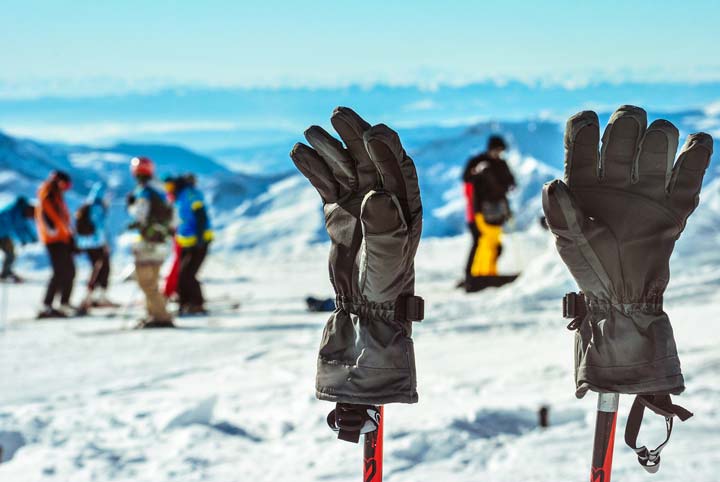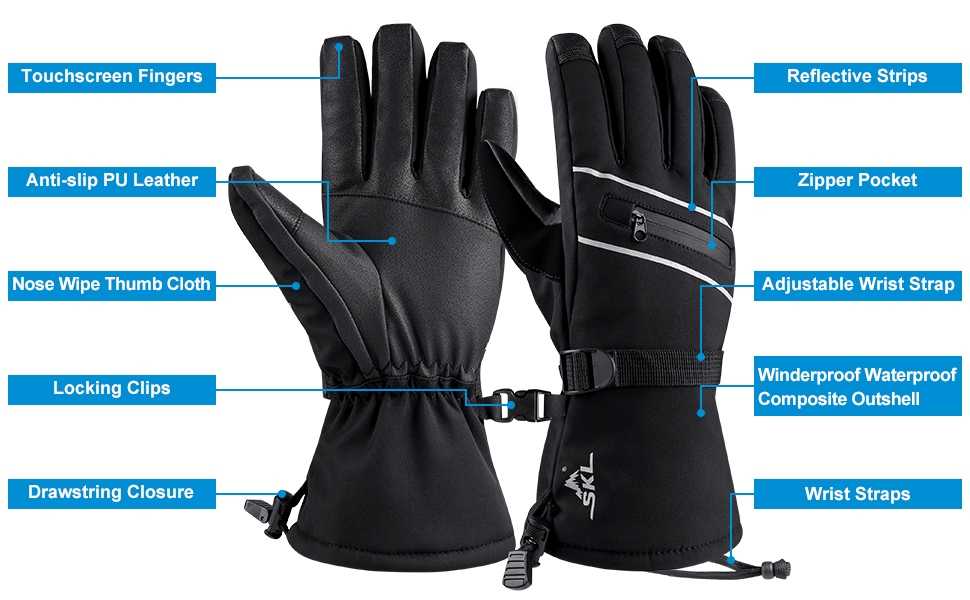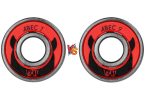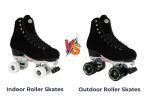Picking the best pair of gloves or mittens is key to helping your hands combat the harsh weather when enjoying snowboarding. Most of us rarely think twice before grabbing that pair of gloves that we think look cool. But we often forget to consider our real needs, which is to have a good experience when snowboarding or skiing whether we are beginners or pros.
Here is an in-depth guide on how to choose snowboard gloves so you can make a statement of fashion, comfort and warmth with ease.
How To Choose Snowboard Gloves – Buying Guide

1. Know your needs
When choosing the right pair, think about your skill and activities. Some gloves and mittens offer a synthetic surface, good breathability, insulation and abrasion-resistant patches that can keep your hands protected and in good shape. These gloves are our top choice for downhill skiing or snowboarding.
If cross-country skiing is your game, consider how breathable and flexible the gloves are because your hands may sweat. Once the decision has been made you can then dig deeper into other features.
2. Gloves vs Mittens
The choice can be narrowed down to four options:
- Gloves are handy when you need to move your fingers a lot. A lightweight version of these gloves is an option for cross country skiing
- Mittens are warmer than gloves and are an appropriate choice when you won’t use your hands much
- Lobsters are the hybrid of gloves and mittens that combine your four fingers in pairs. This is simply the best of both worlds
- The 3-in-1s allow you to mix and match shell and liners so as to adjust for warmth and good mobility
3. Shell material
- Most gloves have a synthetic shell material (primarily nylon) that could differ in quality when it comes to waterproofing and the membranes used. You’ll find both hard or soft versions.
- Leather is long-lasting with a better water resistance capability than nylon. Leather when put together with either grease or a good membrane material produces high quality gloves.
4. Warmth
Judging how cold your hands may get is crucial when choosing snowboarding gloves. If you plan to ski or snowboard in warmer climates, get a pair that provides less warmth and is waterproof; and vice versa when in colder climates. You could also buy heated gloves.
5. Insulation
- Down – this is an excellent choice for drier climates and is warmer than synthetics. But this lacks in breathability and is apt for extremely cold climates and reduced mobility.
- Synthetic – These can either be lofty or thin. Lofty is a good choice when handiness is not an important factor while thin is good for everyday use and increased mobility.
- R-Loft – uses soft microfiber insulation to help preserve warmth even in wet conditions
- Fiberfill – made from polyester fiber which is water resistant and is a good choice to battle the cold
6. Styles
You could find an extremely wide variety – ranging from leather to synthetics, in various colors and shapes. The most popular one remains a simple synthetic exterior paired with a thin insulation layer within. A more modern choice would be pipe gloves, a lightweight pair that allows for better grip but lacks warmth.
7. Size and Fit
The size and fit of your glove are necessary use them with ease and fully enjoy the benefits. A quick way to ensure this is keeping about a quarter of inch of room between the end of the glove and your finger for better mobility.
8. Membrane
- Windstopper – true to its name, this glove blocks wind completely while maintaining its breathability and lightweight. The only con is that it’s not waterproof, making it suitable for cold, dry climates.
- Gore-Tex is a membrane present in between the insulation and external surface that allows for increased ventilation in the gloves and makes it waterproof
- R-Tex’s major pro is that it’s guaranteed waterproof while remaining extremely soft allowing for comfort. We recommend it for cold and wet weather conditions.
9. Palm
Keep in mind that your palms should have an excellent grip. A leather palm is most likely to work better as compared to the synthetic ones considering it protects you against friction and has an excellent grip.
10. Lining
The lining within the glove allows for a higher level of warmth and comfort. It has a good variety, ranging from wool to fleece as well as external lining that could be placed over the glove. Its synthetic nature pulls sweat away from the hand, hence a good quality one will ensure your hands are kept dry.
11. Cuff Style
- Under the cuff – the gloves end along the wrist and work best with a tightened or Velcro jacket sleeve
- Over the cuff – lengthy and extend beyond the jacket sleeves. The major benefit is they offer more protection against snow and wind.
Even though this is primarily a personal choice, this should be made keeping in mind your sleeve length.
12. Heating technology
Today’s top-notch snowboarding gloves often come with a heated feature powered by batteries or chemical heating. For those of us keen on heat this is a very viable option to consider. There are numerous options under these, namely:
- Nylon heated – these are great for even heating throughout the glove
- Fleece heated – these are for everyday use
- Heated liners – externally attachable and can even be worn alone
- Mittens heated – provide maximum warmth when compared to others
13. Waterproofing
If your expected water resistance standards are high, our recommendation would be to opt for a synthetic glove with either a Gore-Tex (efficient) or R Tex membrane (highly efficient). The combination of both might allow for the maximum water resistance. However, always judge the climatic conditions you will be in to assess your best fit.
14. Ventilation
This generally comes at a cost of sacrificing warmth as most of the materials offered for comfort lack in the warmth department. Keeping the material thin to medium thin is key to making sure your skin can breathe. However, there are a few exceptions that may combine both depending on brands.
15. Extra Features
- Touchscreen compatibility- many snowboard gloves are equipped with this feature which is important if you expect to be using your phone before after or during the sport
- Articulated Fingers – the curved edges of the fingers allow for a better grip, which makes holding onto things a lot easier
- Zippered pockets- as said before, a lot of accessories are detachable and hence these are used in case your hand warmers need to be slipped in

- Powder Gaiters and Straps – is a garment around your wrists that keep the warmth while taking away excessive moisture from your hands.
- Wrist Loops – these are insurance for your gloves. They hold onto them in case they fall off, making sure you don’t lose them.
- Wrist and Cuff Closure System- these are for those jackets that lack Velcro to hold onto gloves and keep them tight
- Nose Wipe- to avoid the struggle off finding or keeping tissue on you, these are built on your thumb to wipe your nose during all those edgy moments
- Mini Squeegee- if keeping your goggles clean is a problem then having this sewn onto your gloves’ thumbs would be an easy way to maintain clear goggles
- Padding- for those of us worried about the safety of our hands, extra padding helps avoid any potential damage from accidents
- Leashes or wrist cords – as the name suggests – keep your gloves on a leash. They can either be sewn in or tied and the recent models often have them
- Thumb wipes are the same as nose wipes
- The gloves should be made of such materials so that you can easily wash and dry them.
FAQ
1. What’s better for snowboarding – mittens or gloves?
Ans. Many prefer mittens for their warmth but have to give up on mobility for it. For those who prefer that over warmth, they opt for gloves. This completely depends on your needs
2. Do leather gloves stretch or shrink
Ans. Yes they do. The gloves may stretch if they are too tight for the hand and wet leather could shrink when exposed to heat.
3. What happens if you wear gloves all day long?
Ans. No serious damage occurs since your hands are kept dry and clean. However, extended amounts of time in the glove with moisture-filled hands could cause fungal infections.
4. Can vinyl gloves cause cancer?
Ans. Well, they possibly could because they allow certain types of bacteria and viruses through while containing chemicals that may harm you. We highly discourage vinyl gloves for your safety.









Leave a Comment